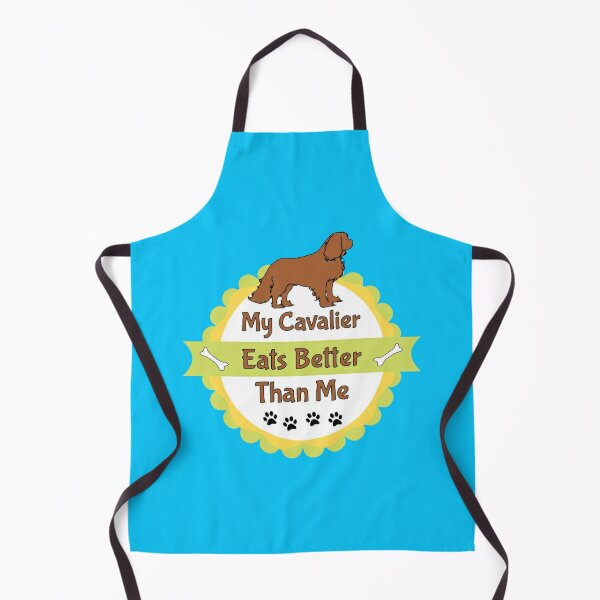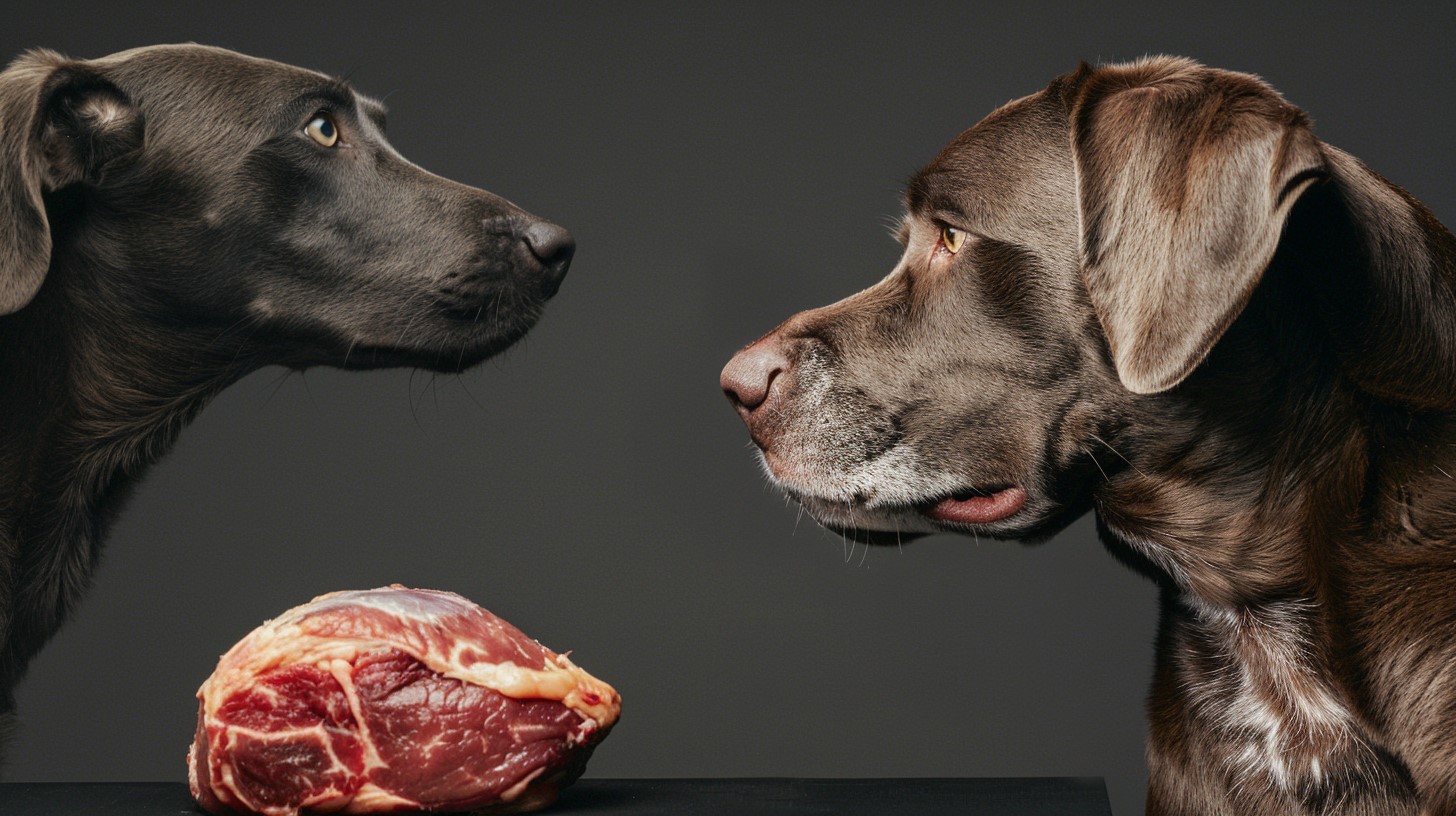Compared with most kibble, both raw and home cooked dog food can be healthier for your dog as long as you meet all their nutritional needs (don’t worry, this isn’t as hard as you may think).
In this article we’ll cover the pros and cons of both raw and home cooked food for your dog, but it may boil down to personal preference.
Let’s dig in…
How to decide: Raw vs Home Cooked
I live by the philosophy anything goes for my dog (and cat), as long as I cover the necessary meats, organs, and bones (plus a few extras). As such I feed them a lot of raw, and also home cooked.
Take table scraps for example, when it comes to meat that’s mostly “home cooked”. Unless you like your steak rare and bloody that is.
This philosophy makes my life easy, and unlike most raw feeders I don’t weigh all my dogs food to the milligram and cross-reference to an Excel spreadsheet full of complex formulas and ratios.
I don’t do that for me, either. Can you imagine if we did that?
Let’s take a look at the pros and cons of Raw vs Home Cooked dog food. From reading these quick fire points you may decide on one or the other, or to hell with it and opt for a combo of both.
Pros & Cons of Raw Dog Food
Pros:
- Better nutrient retention – Science is quite clear on the fact cooking alters the nutritional value of a food. Therefore feeding your dog raw is the best and most natural in terms of nutrients.
- Dental health – I can’t stress this point enough, that most dogs and cats fed commercial pet foods suffer from poor dental health. Believe me, I’ve seen the affects of poor dental health in the veterinary clinic and have personally extracted rotting teeth from rotting jaws of pets barely in their middle age. Chewing on raw meaty bones, or raw meat for that matter, is what I consider the optimal method of keeping dental health in check and warding off tartar buildup.
- Shiny glossy coat and healthy skin – This is multifactorial and most dogs I come across with itchy skin and dull coat are fed kibble on the cheaper end of the grain-based category (wheat, ambiguous cereals, colorings, artificial preservatives etc). For those dogs, switching to raw (or home cooked) show improvements to skin and coat within a matter of weeks. The natural animal fats and nutrients in raw meats and organs work wonders for skin and coat – a clear sign that overall health is also improving dramatically.
- Better weight – When I see an overweight dog and ask the owner (politely) what they feed, I’m never surprised by the answer. High-carb kibble, 90%+ of the time. I find dogs naturally retain a healthy weight on a raw diet, and it’s not surprising given their biology is geared to digest raw food. I’ll add a great quote below – it’s from an Australian chef who I must add has suffered some controversy (like many during the COVID pandemic), but it’s a resoundingly good quote.
- Reduced allergies – Veterinarians tend to assume any dietary reaction is caused by meat proteins, such as chicken or lamb. Although this is true for some dogs, we also see many more dogs who suffer dietary sensitivities. Ask yourself if that’s the same thing when a sensitivity is more about species-inappropriate food being consumed by your dog. Many fail to realize pet food products are always about profit, and the biggest profit is made with cheap ingredients. Are those ingredients optimal for your dog? Cereals, colors, preservatives, additives, wheat mites, all cause reactions considered as allergic, when the reality is it’s a mere reaction to putting the wrong food in your dog’s mouth. Even when it comes to meat allergies, you may find your dog reacts to cooked meat and not raw meat, or vice versa – this may help you with your raw vs cooked decision!
- Preparation time – Before you get confused with preparation time being listed as a con as well, compared with home cooking your dog’s food it has to be said raw can be prepared much quicker (unless you weigh every morsel and tick it off on a spreadsheet). When it comes to convenience kibble is king, so if you want to raw or home cook your dog’s food you’ll have to suck up some additional preparation time.
“When you look at every other species on our planet, they all control their weight automatically. The only exception was us and any animal unfortunate enough to be fed by us.”
~ Pete Evans, Australian Chef
Cons:
- Bacteria is real! – Yes, you knew this already! Raw meat can contain harmful bacteria like Salmonella or E. coli. That’s why we’re careful when we prepare meat, and always clean and wash our hands afterwards. However, although bacterial contamination can affect a dog with a compromised immune system, generally they are much better equipped to deal with bacteria than us. That means the biggest risk of feeding raw meat to our dogs is to us, from not being careful with the prep work.
- Improper imbalance – I don’t hear it as often these days, but 10+ years ago many dog owners heard kibble was unhealthy and consequentially switched to feeding chicken and beef mince. I remember chatting with a director of a global pet food company circa 2015, and he quoted “The best diet for a dog is a raw food diet, and the worst diet for a dog is the wrong raw diet”. Wise words, and if you don’t cover all nutritional needs of your dog they’ll eventually suffer nutritional imbalances. Kibble is designed to meet all nutritional needs in every meal as it’s expected that’s all you feed your dog (hence “complete and balanced”), and raw feeders attempt to mimic this per meal too. In reality, like the way we eat, as long as you provide all the necessary foods regularly – meat, organs, bones – they should naturally have “balance”.
- Potential for choking – Bones have risks, right? More so if you feed inappropriate bones for the breed and temperament of your dog. No weight-baring bones, and definitely no cooked bones. If your dog’s a gulper and inhales food, be wise, and take precautions. Ground bone is an option, but note this counteracts the pro mentioned above regarding dental health.
- Expense – There’s an opinion high-quality raw ingredients are expensive, and this applies to home cooked dog food as well. If you’re on a budget, there are some great tips here. You will also find many compare the cost of feeding a dog raw to the cost of feeding a dog rainbow-colored kibble made of wheat and corn. That’s not a valid comparison. Would you compare the cost of fresh chicken to Cheerios? I thought not…
- Preparation time – This is honestly where I struggle. My fridge is often crammed with meat and organs for the dog, and I barely have space for my own food. Preparing raw also takes time, and if you have a busy family life like I do you’ll often wonder if you spend more time preparing your dog’s food than your own. In fact, my diet definitely suffers because I spend too much time feeding my dog and cat. However, this is probably more a con when it comes to home cooked dog food!
- Storage – Both raw and home cooked dog food require a lot of storage, especially if you prepare meals in advance (which is sensible, right?). I had to invest in a really big fridge, and whenever anyone comments on the size of it I joke “I needed something big for road kill”. Be prepared to sacrifice a great deal of fridge and freezer space for the sake of your dog’s raw food diet.
“The best diet for a dog is a raw food diet, and the worst diet for a dog is the wrong raw diet”
~ A director of a global pet food company (now retired)
Pros & Cons of Home Cooked Dog Food
Pros:
- Reduced risk of contamination – This will likely be what sways you to home cooked dog food over raw. Any raw purist will intimidate you to tears for not feeding your dog “what nature intended”, but I dispute this and would urge you not to worry. I feed my dog bone broth – that’s home cooked – and minced meat, organs, and some veggies and garlic – and that’s home cooked. From my many years involvement in the pet food industry I would much rather feed that to my dog than most brands of kibble. Yes, it will mean you’re losing out on some of the benefits of raw (such as nutrient retention and shorter prep time), but if you’re concerned about harmful bacteria then it’s not much of a trade off.
- Convenience, adaptability, and customization – As someone who home cooks around 50% of their dog’s diet, and feeds the rest raw, it has to be said there’s convenience in cooking your dog’s food when you combine it with your own. In fact, this is where my diet has become better from simply making food which my dog (and cat) can also eat. When I buy food for myself, I make sure I can feed some to my pets as well – and this actually saves money. Meat or fish, perhaps some sweet potato, carrot, a little garlic, herbs, or whatever – I always make enough for them as well. This gives them variety and a mix of nutrients. On the flipside, for my benefit, sometimes I have some cooked liver, kidney, or other organs, and sharing bone broth with my pets is both healthy and super nutritious for all of us.
Cons:
- Improper imbalance – You’ll note this was a con for raw feeding as well, as if you don’t offer your dog all the nutrients they need (which are from organ meats and bones as well as muscle meats), then over time they may suffer a nutritional imbalance which can manifest in illness or a worrying health condition. Some mitigate this risk with a vitamin and mineral supplement – it’s a good option if you’re happy to suck up the cost – but shouldn’t be necessary if you’re confident you’re covering all their nutritional needs. With 100% home cooked you’ll need to find an alternative to the calcium and nutrients in bone (you absolutely cannot give your dog cooked bones), so may turn to bone meal, powdered supplements, eggshells, fish with edible bones, or so forth, but raw meaty bones will always be the easier option.
- Preparation time – If you thought preparing raw was time consuming, preparing home cooked dog food is much more time consuming. How much time do you want to spend in the kitchen wearing an apron which says “My Dog Eats Better Than Me”? (See pic below!) My personal advice is to adapt to cooking food for both yourself and your dog, and I mentioned the benefits of this above.
- Storage – Like with raw feeding, home cooked dog food will also have demands for fridge and freezer space. Most raw and home cooked feeders prepare meals in advance. It’s never something I’ve managed to get used to (because I’m unorganized), but it’s definitely wise and offers you more convenience throughout the week. Just make sure you have a big enough fridge/freezer.

I expect the above pros and cons cover the more important considerations when deciding whether to raw or home cook your dogs food? If you can think of anything else, let me know in the comments.
It’s better to consider there are no right or wrongs. All our situations are different, and compared to kibble you can argue raw vs home cooked dog food is merely a case of comparing too far better, more natural styles of diet than processed pet food.
Common questions on Raw vs Home Cooked Dog Food
Hopefully the above comparison of raw and home cooked dog food helped you make your mind up, but as it’s such a vast topic I’ll treat the remaining section of this article as a FAQ.
If your questions aren’t answered below, drop me a comment and I’ll either add to the FAQ or help you out as best I can.
There are pros and cons of both, but as long as you provide your dog all necessary nutrients from meat, organs, and bones (ground or powdered if cooked) your dog may have a healthier diet than a commercial pet food.
Raw is considered more natural for a dog, with better nutrient retention, but harmful bacteria such as Salmonella or E coli can affect a dog with a compromised immune system or yourself.
Cooked meat can avoid the issue of bacteria, but you should be careful of seasonings or inappropriate ingredients such as excessive salt or onion which may affect your dog.
For more information on whether raw or cooked meat is better for a dog please refer to the main article above.
Generally a dog will adapt to a home cooked dog food without issue if they have been fed a raw diet until this point.
However, if the home cooked diet will contain ingredients which your dog is not used to you may experience loose stools or some discomfort. This should always subside within a few days, but if you find the reaction is excessive or causes vomiting then treat this as a point of concern.
Some allergy-prone dogs may react to cooked meat but not raw, or vice versa, which will manifest as symptoms of vomiting, diarrhea, or gastric discomfort.
Many dogs suffer when transitioning from one form of feeding to another, and this is especially the case when the dog has been fed a limited diet for a long period.
If your dog has been fed one brand of commercial pet food for any length of time you may find they react to any newly introduced foods. This is the same for us when we introduce foods we have become intolerant of over time, and should not be considered a good thing.
If this is the case for your dog, gradually introduce the raw or home cooked dog food over a period of 2 to 3 weeks, monitoring their health, wellbeing, and stools over this time. If your dog shows adverse affects, either transition more gradually or discuss the situation with your veterinarian or a canine nutritionist.
Most arguments against mixed feeding of raw and cooked meats have little scientific merit. We ourselves often eat foods which have different rates of digestion, such as grains vs meats vs vegetables, and I’m sure nobody has ever told you this is a bad idea?
Dogs can benefit nutritionally from both raw and cooked food, and assuming these are species appropriate you should have little reason to be concerned. Personally I have fed my pets a combination of raw and cooked food for many years and not once have they suffered any ill effects.
Cooked bones should never be fed to a dog.
Compared with raw bones appropriate for the size, breed, and temperament of your dog, the risk of cooked bones is much greater.
Splintered cooked bones can cause lacerations or puncture the digestive tract, or become lodged in your dog’s throat or digestive system as an obstruction. This can put your dog in a life-threatening condition and very likely and expensive medical procedure.
Hard cooked bones often lead to dental damage with a risk of broken teeth. Not only will this be painful for your dog, it will require veterinary attention likely at a significant cost.

